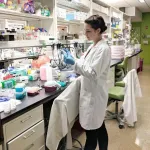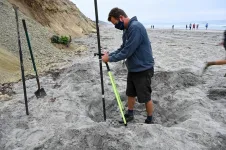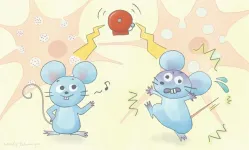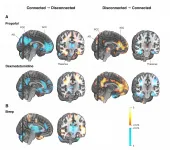(Press-News.org) Cancer cells are known for spreading genetic chaos. As cancer cells divide, DNA segments and even whole chromosomes can be duplicated, mutated, or lost altogether. This is called chromosomal instability, and scientists at Memorial Sloan Kettering have learned that it is associated with cancer's aggressiveness. The more unstable chromosomes are, the more likely that bits of DNA from these chromosomes will end up where they don't belong: outside of a cell's central nucleus and floating in the cytoplasm.
Cells interpret these rogue bits of DNA as evidence of viral invaders, which sets off their internal alarm bells and leads to inflammation. Immune cells travel to the site of the tumor and churn out defensive chemicals. A mystery has been why this immune reaction, triggered by the cancer cells, does not spell their downfall.
"The elephant in the room is that we didn't really understand how cancer cells were able to survive and thrive in this inflammatory environment," says Samuel Bakhoum, a physician-scientist at MSK and a member of the Human Oncology and Pathogenesis Program.
According to a new study from Dr. Bakhoum's lab published December 28 in the journal Cancer Discovery, the reason has to do, in part, with a molecule sitting on the outside of the cancer cells that destroys the warning signals before they ever reach neighboring immune cells.
The findings help to explain why some tumors do not respond to immunotherapy, and -- equally important -- suggest ways to sensitize them to immunotherapy.
Detecting Dangerous DNA
The warning system Dr. Bakhoum studies is called cGAS-STING. When DNA from a virus (or an unstable cancer chromosome) lands in a cell's cytoplasm, cGAS binds to it, forming a compound molecule called cGAMP, which serves as a warning signal. Inside the cell, this warning signal activates an immune response called STING, which addresses the immediate problem of a potential viral invader.
In addition, much of the cGAMP also travels outside the cell where it serves as a warning signal to neighboring immune cells. It activates their STING pathway and unleashes an immune attack against the virally infected cell.
Previous work from the Bakhoum lab had shown that cGAS-STING signaling inside of cancer cells causes them to adopt features of immune cells -- in particular, the capacity to crawl and migrate -- which aids their ability to metastasize. This provided part of the answer to the question of how cancer cells survive inflammation and aid metastasis in the process. The new research shows how the cancer cells cope with the warning signals that activated cGAS-STING releases into the environment. A scissor-like protein shreds the signals, providing a second way the cells can thwart the threat of immune destruction.
Examples of human triple negative breast cancer staining negative (left) and positive (right) for ENPP1 expression.
Examples of human triple negative breast cancer staining negative (left) and positive (right) for ENPP1.
The scissor-like protein that coats cancer cells is called ENPP1. When cGAMP finds its way outside the cell, ENPP1 chops it up and prevents the signal from reaching immune cells. At the same time, this chopping releases an immune-suppressing molecule called adenosine, which also quells inflammation.
Through a battery of experiments conducted in mouse models of breast, lung, and colorectal cancers, Dr. Bakhoum and his colleagues showed that ENPP1 acts like a control switch for immune suppression and metastasis. Turning it on suppresses immune responses and increases metastasis; turning it off enables immune responses and reduces metastasis.
The scientists also looked at ENPP1 in samples of human cancers. ENPP1 expression correlated with both increased metastasis and resistance to immunotherapy.
Empowering Immunotherapy
From a treatment perspective, perhaps the most notable finding of the study is that flipping the ENPP1 switch off could increase the sensitivity of several different cancer types to immunotherapy drugs called checkpoint inhibitors. The researchers showed that this approach was effective in mouse models of cancer.
Several companies -- including one that Dr. Bakhoum and colleagues founded -- are now developing drugs to inhibit ENPP1 on cancer cells.
Dr. Bakhoum says it's fortunate that ENPP1 is located on the surface of cancer cells since this makes it an easier target for drugs designed to block it.
It's also relatively specific. Since most other tissues in a healthy individual are not inflamed, drugs targeting ENPP1 primarily affect cancer.
Finally, targeting ENPP1 undercuts cancer in two separate ways: "You're simultaneously increasing cGAMP levels outside the cancer cells, which activates STING in neighboring immune cells, while you're also preventing the production of the immune-suppressive adenosine. So, you're hitting two birds with one stone," Dr. Bakhoum explains.
The pace of the research has been incredibly fast, he says. "One of the things I would be really proud of is if this research ends up helping patients soon, given that we only just started this work in 2018."
He hopes there will be a phase I clinical trial of ENPP1 inhibitors within a year.
INFORMATION:
This study received financial support from the National Institutes of Health (grants DP5OD026395, K08CA222663, and U54CA225088), the NCI Breast Cancer SPORE (P50CA247749), the Burroughs Wellcome Fund Career Award for Medical Scientists, the Parker Institute for Immunotherapy at MSKCC, the Josie Robertson Foundation, and the MSKCC core grant (P30-CA008748); the Breast Cancer Research Foundation, the Louis V. Gerstner, Jr. Scholars Program, an HICCC core grant (P30CA013696), the Oxford Institute for Radiation Oncology, the Prostate Cancer Foundation, the American Society of Clinical Oncology, the Academy of Medical Sciences, HSC Research Development Division of the Public Health Agency in Northern Ireland and the Friends of the Cancer Centre, Swim Across America, Ludwig Cancer Research, and Nonna's Garden Foundation. Dr. Bakhoum holds a patent related to some of the work described targeting chromosome instability and the cGAS-STING pathway in advanced cancer. He owns equity in, receives compensation from, and serves as a consultant and on the Scientific Advisory Board and Board of Directors of Volastra Therapeutics Inc. He has also consulted for Sanofi, received sponsored travel from the Prostate Cancer Foundation, and both travel and compensation from Cancer Research UK.
BOSTON - Some police departments in the United States continue to teach officers that neck restraints are a safe method for controlling agitated or aggressive people, but that's a dangerous myth, according to a Viewpoint written by three neurologists at Massachusetts General Hospital (MGH) in JAMA Neurology.
The killing of George Floyd, a Black man who died while being arrested in May 2020 after a police officer pressed a knee to his neck for more than eight minutes, helped spark a national conversation about racial ...
Certain bacteria, known as plant-growth-promoting bacteria (PGPB), can improve plant health or protect them from pathogens and are used commercially to help crops. To further improve agricultural yields, it is helpful to identify factors that can improve PGPB behavior.
Many PGPB form sticky communities of cells, known as biofilms, that help them adhere to plant roots. A group of scientists in North Carolina and Massachusetts were interested in finding other plant-associated bacteria that could help PGPB better adhere to plant roots, with the hope that increasing the number of PGPB cells attached to roots would increase their beneficial activities. ...
Scripps Institution of Oceanography at UC San Diego researchers have uncovered how rain and waves act on different parts of coastal cliffs.
Following three years of cliff surveys in and near the coastal city of Del Mar, Calif., they determined that wave impacts directly affect the base, and rain mostly impacts the upper region of the cliffs.
The study appears in the journal Geomorphology and was funded by California State Parks. California's State Parks Oceanography program supports climate adaptation and resilience efforts through coastal and cliff erosion observations and modeling, ...
Below please find a summary and link(s) of new coronavirus-related content published today in Annals of Internal Medicine. The summary below is not intended to substitute for the full article as a source of information. A collection of coronavirus-related content is free to the public at http://go.annals.org/coronavirus.
1. Review concludes universal mask use by lay persons reduces the spread of viral infections including SARS-CoV-2
Findings affirm policy promised by President-Elect Biden, who will ...
What The Study Did: This study identified racial/ ethnic, sex, age, language, and socioeconomic differences in accessing telemedicine for primary care and specialty ambulatory care; if not addressed, these differences may compound existing inequities in care among vulnerable populations.
Authors: Srinath Adusumalli, M.D., M.Sc., of the Hospital of the University of Pennsylvania in Philadelphia, is the corresponding author.
To access the embargoed study: Visit our For The Media website ...
What The Study Did: Severe COVID-19 is characterized by the intense formation of neutrophil extracellular traps (NETs), leading to the blockage of microvessels, as shown in pulmonary samples. The occurrence of ST-elevated myocardial infarction (STEMI) is a serious cardiac manifestation of COVID-19; the intrinsic mechanism of coronary thrombosis appears to still be unknown. This case series report of five patients sought to determine the role of NETs in coronary thrombosis in patients with COVID-19.
Authors: Ana Blasco, M.D., Ph.D., of the Hospital Universitario Puerta de Hierro-Majadahonda in Madrid, Spain, is the corresponding ...
In 1986, cellular biochemist Kazumitsu Ueda, currently at Kyoto University's Institute for Integrated Cell-Material Sciences (iCeMS), discovered that a protein called ABCB1 could transport multiple chemotherapeutics out of some cancer cells, making them resistant to treatment. How it did this has remained a mystery for the past 35 years. Now, his team has published a review in the journal FEBS Letters, summarizing what they have learned following years of research on this and other ATP-binding cassette (ABC) transporter proteins.
ABC transporter proteins are very similar across species and have various ...
Scientists have suspected mutations in a cellular cholesterol transport protein are associated with psychiatric disorders, but have found it difficult to prove this and to pinpoint how it happens. Now, Kazumitsu Ueda of Kyoto University's Institute for Integrated Cell-Material Sciences (iCeMS) and colleagues in Japan have provided evidence that mice with disrupted ABCA13 protein demonstrate a hallmark behaviour of schizophrenia. The team investigated ABCA13's functions and published their findings in the Journal of Biological Chemistry.
ABCA13 belongs to a family of cellular transporter proteins called ATP-binding ...
Philadelphia, December 29, 2020 - Posttraumatic stress disorder (PTSD) is a complex psychiatric disorder brought on by physical and/or psychological trauma. How its symptoms, including anxiety, depression and cognitive disturbances arise remains incompletely understood and unpredictable. Treatments and outcomes could potentially be improved if doctors could better predict who would develop PTSD. Now, researchers using magnetic resonance imaging (MRI) have found potential brain biomarkers of PTSD in people with traumatic brain injury (TBI).
The study appears in ...
What happens in the brain when our conscious awareness fades during general anesthesia and normal sleep? Finnish scientists studied this question with novel experimental designs and functional brain imaging. They succeeded in separating the specific changes related to consciousness from the more widespread overall effects, and discovered that the effects of anesthesia and sleep on brain activity were surprisingly similar. These novel findings point to a common central core brain network fundamental for human consciousness.
Explaining the biological basis of human ...



